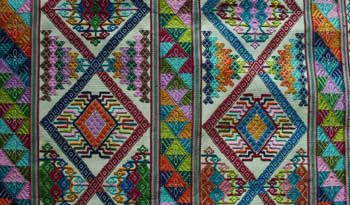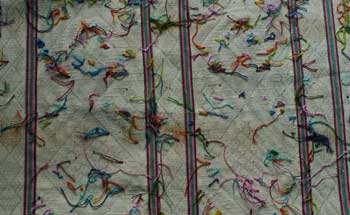 A Tingma is a Bhutanese weft pattern design which uses discontinuous supplementary wefts in addition to a ground weft. This photo illustrates a lovely example this type of weave. Usually woven for the women’s dress (Kira), this is a smaller table runner size. A silk on silk textile, it looks alot like embroidery and the technique for creating it is rather like embroidering around the warp threads as the cloth is woven – row by row.You can also see the back of the cloth with the supplementary weft ends pushed to the back of the cloth and left in their expansive and disarrayed state. The back of the cloth tells me just as much about the weaving and its technique as the front. The back tells me that the supplementary wefts (ie the wefts that weave the fancy coloured patterning) were inserted in an open shed. Only the top threads of the open shed were manipulated to place the supplementary weft across. The front of the cloth tells me how those threads wove in and out to create the pattern.
A Tingma is a Bhutanese weft pattern design which uses discontinuous supplementary wefts in addition to a ground weft. This photo illustrates a lovely example this type of weave. Usually woven for the women’s dress (Kira), this is a smaller table runner size. A silk on silk textile, it looks alot like embroidery and the technique for creating it is rather like embroidering around the warp threads as the cloth is woven – row by row.You can also see the back of the cloth with the supplementary weft ends pushed to the back of the cloth and left in their expansive and disarrayed state. The back of the cloth tells me just as much about the weaving and its technique as the front. The back tells me that the supplementary wefts (ie the wefts that weave the fancy coloured patterning) were inserted in an open shed. Only the top threads of the open shed were manipulated to place the supplementary weft across. The front of the cloth tells me how those threads wove in and out to create the pattern.

I’m currently counting, making stories and analyzing these threads. The first most interesting discovery was the ‘locked down’ nature of the lines that sit horizontally on the fabric. Normally horizontal lines of pattern go over a number of ends and are caught by one or two ends at regulated patterned intervals
The ingenuity and tenacity of this textile lies in the use of soumak on a very fine scale to produce the horizontal veins. This locks down the weft and creates more options for design that we may avoid due to the possiblity of floats that may be too long.

Leave a Reply